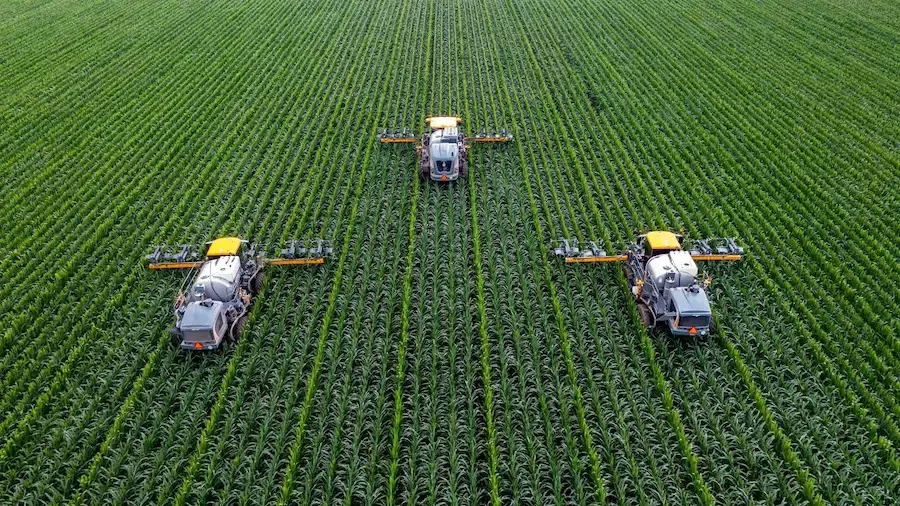
Digitalization will help us tackle our most pressing global problems – such as growing enough food. Image: Unsplash/James Baltz
- To beat the climate crisis and mitigate its impacts, we need to unleash the power of digitalization.
- Digital technology could deliver one-fifth of the emission cuts we need to hit net-zero by 2050.
- Here are three principles to be guided by as we accelerate the digital revolution.
Thankfully, climate change is now a mainstream issue. Businesses, policy-makers, and the public already know about the need (and cost) for greening economies, the importance of protecting biodiversity, and the fact that the status quo is not sustainable.
The question is what we do about it. And while there are many ways to address climate change, they often boil down to one word: reduce.
That makes sense. We should reduce the quantities of fossil fuels we burn. We should reduce deforestation. We should reduce the amount of waste we produce.
But not all reductions are equal.
The degrowth movement, for example, states that successful climate action requires deprioritizing economic growth. This would lead to reductions, for sure – reductions in living standards, healthcare provision and people’s ability to earn a wage. Degrowth might have a romantic appeal but it is neither practical nor realistic, particularly in the middle of a global cost-of-living crunch.
Instead, we should focus more on ‘more’. We should set about making renewable energy more efficient, industry more productive, policy-making more urgent and businesses more transparent.
This positive vision depends on one specific ‘more’: More digitalization.
There is no green without digital. It is the ultimate enabling process. As well as getting greener itself – studies suggest that 5G networks are up to 90% more energy efficient per traffic unit than legacy 4G networks, for example – digitalization also unlocks huge environmental gains in other sectors.
Recent estimates from the World Economic Forum and Accenture suggest that digital technologies could deliver up to one-fifth of all the reductions needed to achieve the 2050 net-zero goals in energy, materials and mobility. And that’s not to mention other sectors such as logistics and manufacturing.
Here are two examples.
1. Energy generation
The biggest offshore wind turbines today are over twice as tall as those installed only five years ago.
But the bigger the turbine, the further offshore they need to be, and the more complicated the maintenance process.
Digitalization can offer a range of fixes. For example, covering even the biggest wind farms with a single private wireless network can unlock solutions including predictive maintenance, repair analysis drones and augmented reality engineering. As a result, engineers make fewer trips out to sea and more turbines can be kept at peak output.
Digitalization is making other forms of energy generation more efficient too. For example, advances in artificial intelligence (AI) make ‘tracking’ solar arrays, which follow the sun during the day, up to 45% more productive than static arrays.
In addition to making it easier to bring renewables on-grid, fully digitalized and AI-managed energy systems can identify who needs energy, when they need it, and deliver it at the lowest possible cost.
Digitalization like this will allow the integration of essentially limitless renewables into the grid, because variations in generation can be balanced instantly either by other sources of power or adjusting demand.
One small-scale example is Nokia’s project with Siemens and A1, creating an ultra-efficient microgrid for Siemens’ corporate campus in Vienna. The microgrid matches the campus’ energy requirements with on-site wind and solar energy generation. This reduces reliance on offsite energy and cut carbon emissions on the campus by around 100 tonnes per year in 2021, with double that figure predicted for this year.
2. Digital farming
The UN predicts that farms will need to produce 70% more food, on 5% more land, by 2050. Digitalization can make this possible.
The classic example is burying sensors in the soil, ensuring that crops get exactly the right amount of water and fertilizers.
This is valuable, but it isn’t the end of the story.
Satellites and drones can use biomass-sensitive imaging to grade the health of vast swathes of crops. Connected farming machinery can pair this data with information on soil condition, weather forecasting and seed availability to keep farms at optimum efficiency.
Digitalizing 15%-25% of global agriculture in this way could increase global production by 300 million metric tonnes by 2030 and reduce water consumption by up to 150 billion cubic metres every year.
One problem, as suggested in a recent study by EY, is that farmers can be reluctant to share data. This is a sticky issue. Almost every industry and institution struggles with a trust deficit at the moment.
Digitalization cannot solve this problem alone, but digitalizers can do their bit by recognizing the importance of reliability and security, and working with trusted partners while rolling out digitalization.
What's next on digitalization?
We know the willpower exists to accelerate this process. Look at the First Movers Coalition – a public-private partnership involving the World Economic Forum, Nokia and other contributors who commit to purchasing new sustainable technologies.
Discussions on digitalization here at Davos should bear three principles in mind:
1. The only realistic path to net zero involves mobilizing market forces.
The EU created the first ever emissions trading system. Between 2005 and 2020, emissions covered by the scheme dropped by over 40%.
We can replicate that elsewhere.
2. Radio spectrum matters.
Almost all wireless telecommunications need some radio spectrum to function. Without it, none of the use cases mentioned here would be possible.
The trouble is, it’s a finite resource. Ultimately, governments control who gets access to what spectrum. They should release affordable new spectrum across low, mid, high and ultra-high-band ranges – and businesses and other stakeholders should keep pressing them to do so.
3. Businesses have a responsibility to do the right thing.
Play by the rules, behave ethically, and build trust.
In other words, make tech, and tech companies, a force for good.
Be proactive. Pursue waste and emissions goals with the same innovative attitude you use for any business-critical issue.
And finally, digitalize. Go fast. Get ahead of the pack. The planet is counting on you.


